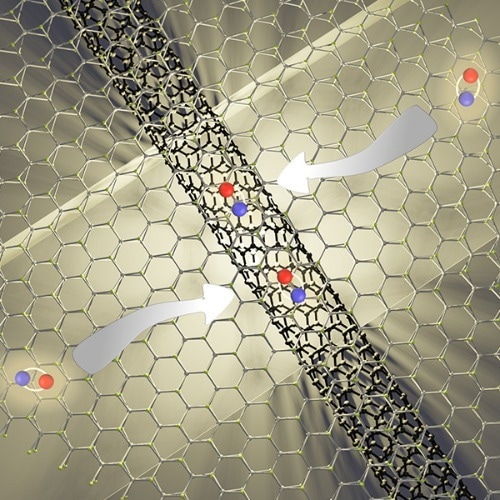Carbon nanotubes can glow brilliantly when light is absorbed by a flat sheet of atoms acting as an antenna to direct that energy into the tubes. This breakthrough might help create future tiny light-emitting devices that make use of quantum phenomena.
 An atomically thin flake of tungsten diselenide acts as a reservoir for excitons, which are made up of electrons (red) and holes (blue). These excitons quickly pass into a narrow carbon nanotube suspended over a trench. Image Credit: RIKEN Nanoscale Quantum Photonics Laboratory
An atomically thin flake of tungsten diselenide acts as a reservoir for excitons, which are made up of electrons (red) and holes (blue). These excitons quickly pass into a narrow carbon nanotube suspended over a trench. Image Credit: RIKEN Nanoscale Quantum Photonics Laboratory
Carbon nanotubes have a diameter of around a nanometer and resemble very thin, hollow wires. They have several ways of producing light. For instance, a laser pulse can cause positively charged “holes” to form in a material by exciting negatively charged electrons. When these opposing charges combine, they can create an exciton, an energetic state that can move down a nanotube for a considerable distance before releasing its energy as light.
This phenomenon can potentially be used to create extremely effective nanoscale light-emitting devices.
Unfortunately, there are three barriers to utilizing a laser to produce excitons within carbon nanotubes. First, a laser beam is often 1,000 times broader than a nanotube, thus the material absorbs relatively little energy. Second, the light waves must be exactly aligned with the nanotube to distribute their energy efficiently. Finally, electrons in a carbon nanotube can only absorb light at specified wavelengths.
To circumvent these constraints, a team led by Yuichiro Kato of the RIKEN Nanoscale Quantum Photonics Laboratory resorted to another type of nanomaterial, known as 2D materials. These flat sheets are only a few atoms thick; nevertheless, they could be considerably larger than a laser beam and are significantly more effective at turning laser pulses into excitons.
The team grew carbon nanotubes over an insulating trench. They then layered an atomically thin flake of tungsten diselenide on top of the nanotubes. When laser pulses struck this flake, they produced excitons, which traveled inside the nanotube and down its length before emitting light with a larger wavelength than the laser. Each exciton took only one trillionth of a second to travel from the 2D substance to the nanotube.
The researchers found optimal nanotube shapes that promote the transfer of excitons from the 2D material by evaluating nanotubes with a variety of distinct configurations that impact critical energy levels inside the material. They want to apply band engineering, a helpful idea in semiconducting engineering to create devices with better characteristics at the atomically thin scale in light of this discovery.
When band engineering is applied to low-dimensional semiconductors, new physical properties and innovative functionalities are expected to emerge. We hope to utilize this concept to develop photonic and optoelectronic devices that are just a few atomic layers thick. If we can shrink them to the atomically thin limit, we expect novel quantum effects to emerge, which may become useful for future quantum technologies.
Yuichiro Kato, Chief Scientist, Nanoscale Quantum Photonics Laboratory, RIKEN
Journal Reference:
Fang, N., et. al. (2023) Resonant exciton transfer in mixed-dimensional heterostructures for overcoming dimensional restrictions in optical processes. Nature Communications. doi:10.1038/s41467-023-43928-2.